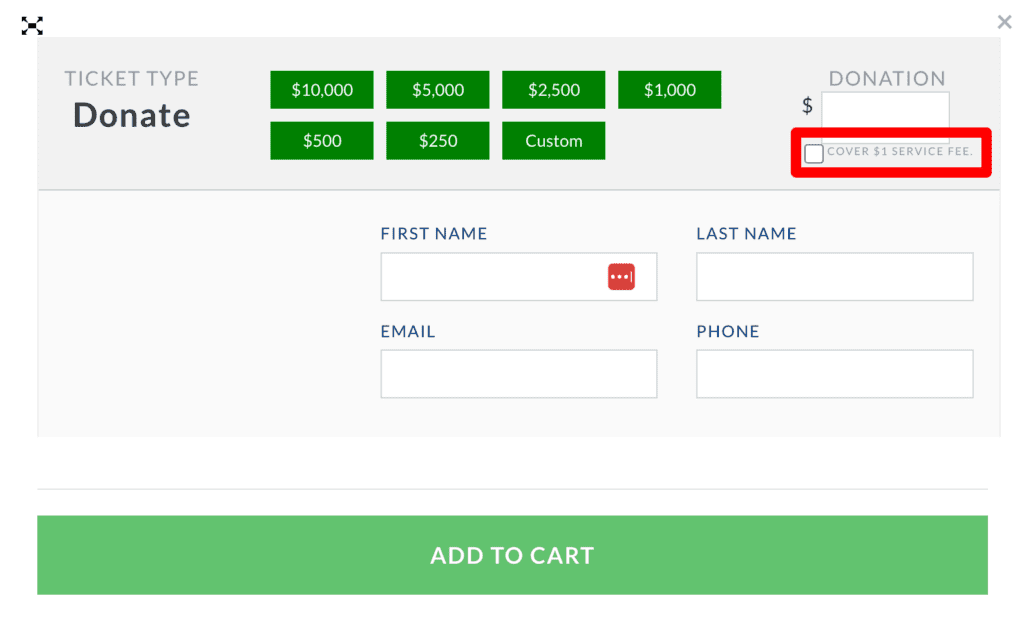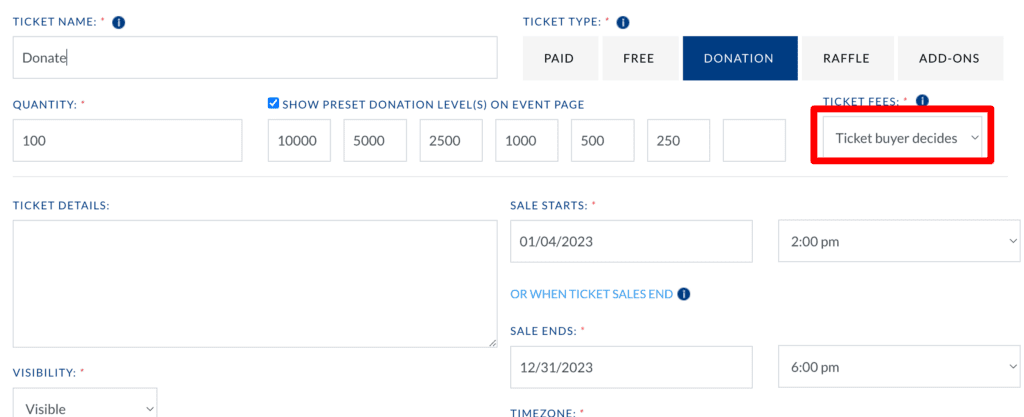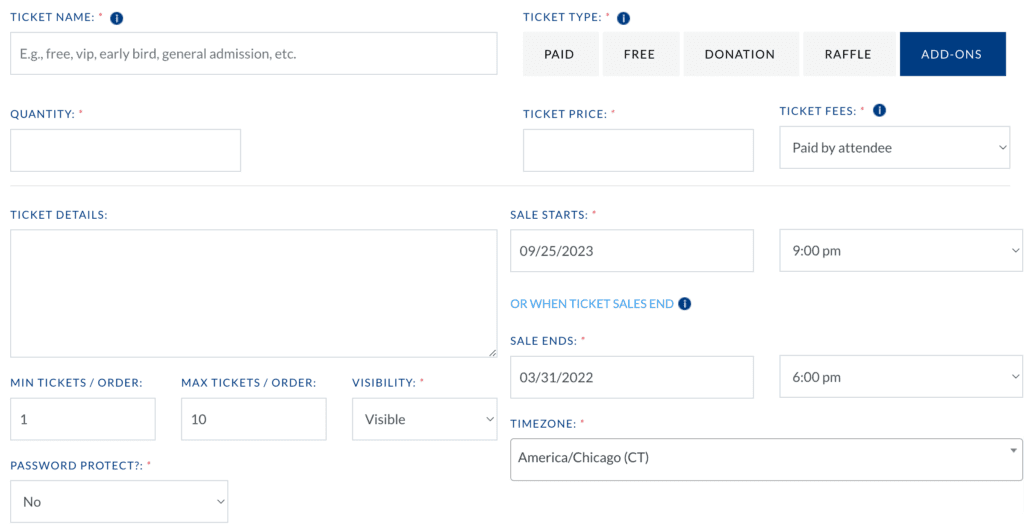Easily Swap Seats from the Event Dashboard for Reserved Seating Events
Have you ever wanted to change an attendee's seat for a reserved seating event after s/he purchased tickets? You can now do so with our swap seats feature. To swap an attendee's seat, visit the event dashboard for your reserved seating event and scroll down to the attendee summary section. Search for the attendee in the search field and click on actions > swap seat. A modal will appear with the seating chart for you to select a new seat for the attendee - see the screenshot below. Once you click on a new seat, click save. You will be returned to the event dashboard's attendee section to swap additional seats.

Enable Donors and Ticket Buyers to Choose to Pay Ticketing Fees for Donation Ticket Types
We recently added a new option for event organizers to enable donors and ticket buyers to choose to pay the ticketing fee for donation ticket types. Below is a screenshot of the add-to-cart modal for donation ticket types with this feature enabled.
 To enable donors and ticket buyers to choose to pay the ticket fee for donation ticket types, visit the create/edit tickets page for your event from the manage (shared) events page. Create a new ticket type or edit an existing one. Select donation as the ticket type, and "Ticket buyer decides" from the ticketing fees drop-down, as seen in the screenshot below.
To enable donors and ticket buyers to choose to pay the ticket fee for donation ticket types, visit the create/edit tickets page for your event from the manage (shared) events page. Create a new ticket type or edit an existing one. Select donation as the ticket type, and "Ticket buyer decides" from the ticketing fees drop-down, as seen in the screenshot below.

Collect Donations with Suggested Donation Levels (Presets)
You can now create suggested donation levels (presets) to provide quick options for ticket buyers/donors to click on when donating to your organization/cause. To activate this feature, from the create/edit tickets page, click the "Show Preset Donation Level(s) On Event Page" checkbox and enter up to seven suggested donation amounts. A custom option is displayed automatically for ticket buyers/donors on the donation modal, enabling them to enter a specific amount to give.
 Once your donation presets are saved, the donation modal will look as follows to the ticket buyer/donor.
Once your donation presets are saved, the donation modal will look as follows to the ticket buyer/donor.

Sell Extras, Drink Vouchers and Merchandise with New Add On Ticket Type
We recently released a new add on ticket type to enable event organizers to sell extras like merchandise, food vouchers, drink tickets, VIP experiences, parking, campsites and more. Add on ticket types can be purchased alone or in addition to other ticket types. Visit the create/edit ticket types page and select the Add On ticket type to sell extras.

Crafting Captivating Event Descriptions: A Guide for Event Organizers
When promoting your event, the power of an enticing event description cannot be underestimated. Whether you are organizing a reserved seating or general admission event, capturing the attention and interest of potential attendees is crucial. In this blog post, we will provide event organizers with valuable tips on how to write the best event descriptions for both in-person reserved seating and general admission events. Know Your Event Inside Out: To create a compelling event description, it is essential to have a deep understanding of your event. Familiarize yourself with its unique aspects, highlights, and objectives. Identify the key features that set your event apart from others. Clearly define the event type, whether it is a concert, conference, workshop, or festival. Define the Audience: Before crafting your event description, define your target audience. Consider their demographics, interests, and motivations. Tailor your event description to resonate with the specific audience you want to attract. Start with a Compelling Hook: Grab the reader's attention from the start by using a captivating opening line. Highlight the unique selling points or the most exciting aspects of your event. Create a sense of anticipation and excitement that encourages potential attendees to continue reading. Provide Event Details: Include essential information such as the event date, time, and duration. Specify the venue location clearly to avoid any confusion. Mention any particular features or amenities available at the venue to enhance the overall event experience. Showcase the Event Experience: Use descriptive language to create a vivid picture of the atmosphere and ambiance attendees can expect. Highlight the overall experience, including special performances, speakers, or interactive elements. Engage the reader's senses by describing what they will see, hear, and feel during the event. Highlight Benefits and Value: Communicate the benefits attendees will gain from participating in your event. Emphasize any educational, networking, or entertainment opportunities that attendees can expect. Showcase the unique value they will receive, such as access to industry experts, exclusive content, or one-of-a-kind experiences. Convey a Call to Action: Prompt readers to take action with a clear and concise call to action. Encourage them to purchase tickets, register, or RSVP for the event. Create a sense of urgency by mentioning limited availability or early bird discounts. Make it easy for potential attendees to act upon their interests. Use Engaging and Concise Language: Keep the event description concise and easy to read. Use language that is engaging, descriptive, and evokes emotion. Consider incorporating testimonials or quotes from previous attendees or notable individuals to build credibility and add a human touch. Proofread and Edit: Before publishing your event description, ensure it is free from grammar or spelling errors. Review the content for clarity, coherence, and accuracy. Consider asking a colleague or professional proofreader to provide feedback for further improvements. Optimize for Search Engines: Research and incorporate relevant keywords related to your event. Optimize the event description for search engine optimization (SEO) by including essential details and unique selling points. Use headings, subheadings, and bullet points to enhance readability and structure. Crafting an outstanding event description is a vital step in attracting attendees to your reserved seating or general admission event. By thoroughly understanding your event, defining your target audience, and using engaging language, you can create descriptions that ignite curiosity and excitement. Remember to highlight the event experience, showcase the benefits, and include a compelling call to action. With a well-crafted event description, you will capture the attention of potential attendees and increase the chances of a successful event.
Read MoreStrengthening Event Security: A Comprehensive Guide to Utilizing Stripe Radar for Fraud Prevention
As an event organizer, ensuring the security of your transactions and protecting yourself against fraudulent activities is paramount. With the rise of online payments, a robust fraud prevention system is essential. In this blog post, we will delve into Stripe Radar, an advanced fraud protection tool offered by Stripe, and provide event organizers with insights on what it entails and how to leverage its capabilities to prevent fraudulent transactions effectively. Understanding Stripe Radar: Stripe Radar is a powerful fraud prevention solution that safeguards your event transactions. It seamlessly integrates with Ticket Falcon, leveraging real-time machine learning algorithms and pattern recognition to detect and prevent fraudulent transactions. By collaborating with its global network, Stripe Radar can identify fraud patterns and mitigate risks effectively and quickly. The Importance of Fraud Prevention: Fraudulent transactions pose significant risks to event organizers, impacting revenue and attendee trust. Chargebacks and financial losses can undermine your event's success. Therefore, implementing robust security measures to combat fraud is essential in building trust and credibility with attendees. Getting Started with Stripe Radar: To utilize Stripe Radar, start by creating a Stripe account (if you do not already have one) and enable the Radar feature. Stripe offers different tiers, including Radar Free, Radar One, and Radar Advanced, each with varying features and capabilities. Based on your event's risk tolerance and historical fraud data, configure the Radar settings to align with your specific requirements. Leveraging Features of Stripe Radar: Stripe Radar's machine-learning capabilities are a crucial asset for identifying fraud patterns and adapting to emerging threats in real time. Customize fraud rules based on your event's unique characteristics and historical fraud data to enhance accuracy. Utilize risk evaluation tools to identify suspicious transactions and apply appropriate risk mitigation measures. You can also implement additional layers of security, such as two-factor authentication, to reduce fraud risk further. Best Practices for Fraud Prevention: Address Verification System (AVS) enables verification of billing addresses to ensure authenticity. Utilize IP geolocation data to flag transactions originating from high-risk areas. Analyze device characteristics and behavioral patterns through device fingerprinting to identify potential fraud attempts. Manual review features allow for a detailed examination of suspicious transactions, adding an extra layer of scrutiny where necessary. Continuous Monitoring and Optimization: Regularly review and analyze transaction data, fraud patterns, and chargeback rates to stay proactive. Adjust fraud rules and strategies based on evolving trends and insights derived from the Stripe Radar dashboard. Stay informed about the latest updates and features offered by Stripe to enhance your fraud prevention efforts continually. Collaborating with Stripe Support: Should you require guidance or support in implementing effective fraud prevention strategies, Stripe's support team is available to assist you. Leverage their expertise and stay updated on the latest resources and documentation provided by Stripe to maximize the effectiveness of Stripe Radar. Stripe Radar is a robust capability in combating fraudulent transactions and protecting your event revenue. By leveraging its machine learning algorithms, customizable fraud rules, and risk evaluation tools, you can fortify event security and minimize fraud risks. Implement best practices, continuously monitor and optimize your fraud prevention strategies, and collaborate with Stripe's support team to create a secure and seamless event experience for attendees. With Stripe Radar, you can confidently deter fraudsters and safeguard your event's success while maintaining the trust and satisfaction of your attendees. Take a look at Stripe's Radar for Fraud Teams: 101 to learn more and access over 100 rules to combat fraudulent transactions.
Read More 1
2
3
4
5
6
7
1
2
3
4
5
6
7
